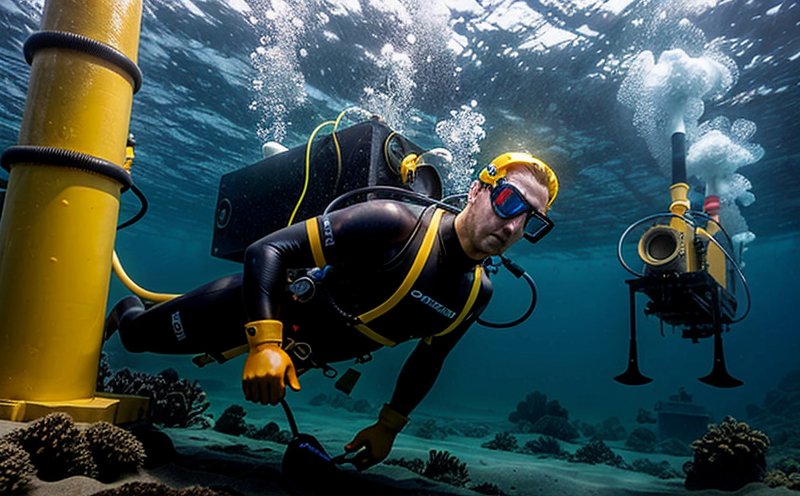ISO 9934 Magnetic Particle Testing of Subsea Steel
The ISO 9934 magnetic particle testing (MPI) method is a non-destructive technique widely used in the marine and ship equipment sector to inspect subsea steel components for surface and near-surface flaws. This service ensures that critical parts meet stringent quality standards before deployment, thereby enhancing operational safety and reliability.
Magnetic Particle Inspection (MPI) involves inducing an electromagnetic field into the material being tested. When a defect is present at or near the surface, it alters the magnetic flux, causing the leakage of magnetic lines of force which attract fine magnetic particles applied to the surface. These particles form visible indications that can reveal the presence and location of flaws.
Subsea steel components are subjected to harsh environmental conditions including pressure, temperature changes, saltwater exposure, and biofouling. Therefore, ensuring their integrity is paramount for preventing catastrophic failures underwater. The ISO 9934 standard provides a robust framework for conducting MPI on subsea steel parts, guaranteeing consistent and reliable results.
The testing process begins with the preparation of the specimen. Prior to application of magnetic particles, surfaces must be cleaned thoroughly using appropriate solvents and abrasives if necessary. This step ensures that any existing contaminants do not interfere with the detection of flaws.
After cleaning, a magnetic field is generated either by passing an electric current through coils surrounding the component or by using permanent magnets attached directly to it. The strength and uniformity of this field are crucial for effective flaw detection.
Magnetic particles in suspension are then applied over the surface under inspection. Commonly used particles include iron oxide pigments mixed with solvents. They can be sprayed, brushed, or poured onto the test piece depending on its geometry and accessibility.
The next step involves careful examination of the component while still maintaining the magnetic field. Any anomalies in the pattern of particle distribution indicate potential flaws such as cracks, porosity, or inclusions within the steel matrix.
Post-inspection, detailed reports are generated documenting all findings along with relevant specifications and compliance data against ISO 9934 guidelines. These records serve as critical documentation for quality control purposes and regulatory compliance.
A key advantage of using ISO 9934 MPI is its ability to detect very small defects that might otherwise go unnoticed through visual inspection alone. This capability enhances overall product reliability by minimizing risks associated with undetected flaws in subsea equipment.
Furthermore, adherence to international standards like ISO 9934 ensures consistency across different laboratories worldwide, facilitating easier collaboration and trade between countries involved in maritime industries.
This service not only adheres strictly to industry best practices but also leverages cutting-edge technology to deliver precise and accurate results every time. By partnering with us for your ISO 9934 magnetic particle testing needs related to subsea steel components, you can rest assured that your equipment will meet the highest standards of quality and reliability.
Applied Standards
| Standard | Description |
|---|---|
| ISO 9934:1980 | Magnetic Particle Testing - General Requirements and Methods |
| ASTM E751-21a | Standard Practice for Magnetic Particle Examination of Ferromagnetic Materials |
| EN 4196:2003 | Magnetic Particle Testing - Methods, Results and Reporting |
International Acceptance and Recognition
The ISO 9934 standard has been widely adopted by industries globally due to its comprehensive approach towards ensuring the integrity of ferromagnetic materials used in various applications. Its acceptance extends beyond national boundaries, making it a preferred choice for companies operating internationally.
Many leading manufacturers and suppliers within the marine sector have incorporated ISO 9934 into their quality management systems (QMS). By doing so, they demonstrate their commitment to upholding high standards of craftsmanship and reliability in all products manufactured or procured. This not only builds trust among customers but also fosters stronger relationships with partners globally.
Furthermore, compliance with ISO 9934 helps organizations meet regulatory requirements set forth by governing bodies such as the International Maritime Organization (IMO). These regulations mandate stringent quality controls to ensure safety at sea. Adherence to these standards ensures that products comply with international maritime laws and regulations.
The widespread adoption of ISO 9934 also promotes best practices within the industry, encouraging continuous improvement in manufacturing processes. As a result, manufacturers can enhance their reputation among peers while maintaining competitive edge through superior product quality.
Competitive Advantage and Market Impact
Implementing ISO 9934 magnetic particle testing offers significant advantages to businesses operating in the marine and ship equipment sector. One major benefit is improved operational efficiency, as defective components are identified early through rigorous inspections conducted according to stringent international standards.
Another advantage lies in enhanced product quality which directly translates into customer satisfaction. When manufacturers consistently produce reliable subsea steel parts that pass ISO 9934 testing, they build a reputation for excellence that attracts more business opportunities both locally and internationally.
The ability to demonstrate compliance with recognized international standards also gives companies an edge over competitors who may not adhere to such high levels of quality assurance. This competitive positioning helps maintain or even increase market share in an increasingly competitive global marketplace.
In terms of long-term impact, investing in ISO 9934 magnetic particle testing ensures sustainability by reducing the likelihood of costly repairs and replacements due to premature failures caused by undetected flaws. It contributes towards a safer operating environment for all stakeholders involved in maritime activities.
By leveraging this service, businesses can position themselves as leaders in their field, demonstrating commitment to excellence and innovation. This strategic approach not only enhances brand image but also opens doors to new markets and partnerships worldwide.





